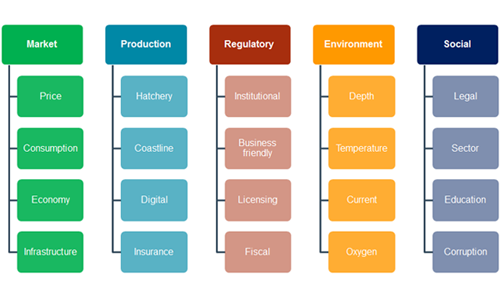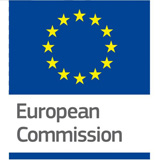You are here: Home > Research and Innovation > Aquaculture Investor Index > Methodology
Methodology
Categories and Indicators
The index measures the outcomes of the categories which are influencers of aquaculture investment.The index is measured through five categories, market, production, regulatory, environmental, and social data at the national level, using quantitative and qualitative assessments to derive an individual category and overall country score.

Market
Market characteristics are fundamental to the decision-making process of aquaculture investment. The market helps stakeholders assess their competitive advantage when compared to like-for-like producers in other European countries competing for market share, as it will assist stakeholders assess which countries provide the best market opportunities.
| Indicator | Metric | Notes |
| Price | Time-series import/export prices from 2007-2015 | Double weight (production and proportion) percent price deviation |
| Consumption | Fish consumption per capita | Time-series per kilogram consumption of fish per capita |
| Economy | Gross Domestic Product (GDP) per capita & current account balance | Measure of economic performance |
| Infrastructure | Rail lines per km2, Air transport, registered carrier departures, and Container port traffic (TEU: 20 foot equivalent units) | Tiered systems measuring rail, air, and port movements |
Production
Production provides an overview of how much existing aquaculture infrastructure is available to investors in different countries. A developed aquaculture supply-chain to service industry needs can reduce risk. Factors ranging from hatchery to insurance availability, can have a material impact on the competitiveness of an aquaculture industry.
| Indicator | Metric | Notes |
| Hatchery & nursery | Production of hatcheries and nurseries at eggs stage in life cycle (millions). Production of hatcheries and nurseries at juvenile stage in life cycle |
X= hatchery and Y=nursery, normalised hatchery/total production and nursery/total production |
| Coastline | Ratio of absolute coastline versus relative coastline | Time-series per kilogram consumption of fish per capita |
| Digital capacity | Mobile phone subscriptions and internet users (per 100 people) | Digital coverage increases the access to information |
| Insurance | Heuristic assessment and/or surveys of the principal insurance markets | Categorisation of the tiers of insurance penetration per country |
Regulatory
Regulation is significant in Europe and often the largest constraint to aquaculture development. Ranking the licensing regulation provides investors with an idea of opportunities to develop aquaculture. Informing potential stakeholders of the licensing and institutional framework is a key component to assist decision-making.
| Indicator | Metric | Notes |
| Institutional | Matrix comparing the percentile rank of government effectiveness, political stability, regulatory quality, voice and accountability | Assessment to determine rankings of institutional frameworks |
| Business-friendly | Matrix comparing the time to start a new business (days), cost of starting a new business (% of GNI per capita), and burden of customs procedure | Assessment to determine the attractiveness of new businesses |
| Licensing | Length of time required to obtain an aquaculture licence | Tiered scoring per months for aquaculture licensing (0-6 months, 6-12 months, 12-18, 18-30, 30+ months), accounting for marine, freshwater aquaculture |
| Fiscal | Fiscal burden through tax revenue (% of GBP) and labour tax and contributions (% of commercial profits) | Relative fiscal burden faced by private enterprise in each country |
Environment
Environment is key to choosing to correct location for aquaculture. Countries where there are pre-disposing conditions for specific types of aquaculture assists investors determine where to allocate resources. The outputs from remote sensing and Geographic Information Service (GIS) based on species criteria yield important information.
| Indicator | Metric | Notes |
| Depth | Area and proportion of a country's Exclusive Economic Zone (EEZ) that falls into different classes | Depth classes: < 10m 10-40m 40-150m 150-300m 300m+ |
| Water temperature | Months during minimum and maximum species temperatures (SST) ranges in a country's EEZ |
6-15oC 12 months (salmon) – CAT1 11-26oC 12 months (bream) – CAT2 8-22oC 12 months (bass) – CAT3 For each category if one month is off, the a point is subtracted, so for CAT1: 6-15oC 11 months’ score 4 6-15 oC 10 months’ score 3 6-15 oC 9 months’ score 2 6-15 oC 8 months or less score |
| Current speed | Current speed area and proportion of a country's EEZ that falls into different classes | Current speed classes: 0-3 cm s-1 50-80 cm s-1 25-50 cm s-1 3-10 cm s-1 10-25 cm s-1 |
| Dissolved oxygen | Dissolved oxygen area and proportion of a country's Exclusive Economic Zone that falls into different classes | Dissolve oxygen classes include: >60 mg/m3 20-60 mg/m3 10-20 mg/m3 5-10 mg/m3 |
Social
Social elements impact the ability to grow aquaculture. The resistance from social aspects is a powerful category for investors to understand the degree of local acceptance and level of conflict aquaculture presents to local stakeholders across different countries. Conflicting uses for water resources generate can have an important social component.
| Indicator | Metric | Notes |
| Legal | Rule of law (percentile rank) | Rule of Law captures perceptions of the extent to which agents have confidence in and abide by the rules of society |
| Sectoral | Value of domestic aquaculture as a percentage of aquaculture, first sale and landings, and import/export seafood | Social license |
| Education and training | Grants and other revenue (% of revenue) and gross enrolment ratio in tertiary education | A proxy for the degree of labour force sophistication |
| Corruption | Control of corruption (percentile ranking) | The extent of which public power is exercised for private gain |



